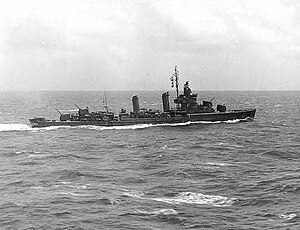USSDuncan(DD-485)

| |
| History | |
|---|---|
| Name | Duncan |
| Builder | Federal Shipbuilding and Drydock Company |
| Laid down | 31 July 1941 |
| Launched | 20 February 1942 |
| Commissioned | 16 April 1942 |
| Fate | Sank on 12 October 1942, north ofSavo Island |
| General characteristics | |
| Class and type | Gleaves-classdestroyer |
| Displacement | 1,630 tons |
| Length | 348 ft 3 in (106.15 m) |
| Beam | 36 ft 1 in (11.00 m) |
| Draft | 11 ft 10 in (3.61 m) |
| Propulsion |
|
| Speed | 37.4 knots (69 km/h) |
| Range | 6,500 nmi (12,000 km; 7,500 mi) at 12 kn (22 km/h; 14 mph) |
| Complement | 16 officers, 260 enlisted |
| Armament | |
USSDuncan(DD-485),aGleaves-classdestroyer,was the second ship of theUnited States Navyto be named afterSilas Duncan,who was severely wounded by enemy fire which caused the loss of his right arm during theBattle of Lake Champlainon 11 September 1814.
Construction and commissioning
[edit]Duncanwaslaunchedon 20 February 1942 byFederal Shipbuilding and Dry Dock Co.,Kearny, New Jersey;sponsored by Mrs. D. C. Thayer. The ship wascommissionedon 16 April 1942,Lieutenant CommanderEdmund B. Taylorin command.
Service history
[edit]Duncansailed from New York on 20 June 1942 for the South Pacific, arrived atEspiritu Santoon 14 September to join TFs 17 and 18, and with them departed the same day to covertransportscarrying the7th Marine Regimentto reinforceGuadalcanal.Duncanwas in the screen of theaircraft carrierWaspnext day when the task force was attacked by two Japanesesubmarines.Waspwas torpedoed, and so severely damaged that she had to be sunk by United States ships.Duncanpicked up survivors from the carrier, transferring 701 officers and men to other ships, and 18 wounded and two bodies to the base hospital at Espiritu Santo upon her arrival 16 September.
Duncancontinued to operate from Espiritu Santo to the Solomons, screening transports and ships of the covering forces. On 11 October 1942, she was in the screen of Task Force 64 (TF 64) which was assigned to protect a vital transportconvoycarrying reinforcements to Guadalcanal. Contact was made with a large enemy surface force just as the American ships were executing a course change as part of their battle plan.Duncan,having a clearradarcontact and seeing herflagshipapparently steady upon a course which would close the target, believed the destroyers were closing to attack, and found herself charging alone toward the enemy force.
In the resultingBattle of Cape Esperance,Duncanhit acruiserwith several salvos, then shifted fire to a destroyer, at the same time maneuvering radically to avoid enemy fire and that from her own forces, who were now joining in the attack. She got off two torpedoes toward her first target,Furutaka,and kept firing until hits she had received put her out of action. The commanding officer, Lieutenant CommanderEdmund B. Taylorwho was awarded the Navy Cross for his actions in this battle ordered the bridge, isolated by fire, abandoned, and the wounded lowered into life rafts. The men on board attempted to beach the ship onSavo Island,but then, believing she might yet be saved, continued to fight the fires until power failed, when they abandoned ship. DestroyerMcCallarescued 195 men from the shark-infested waters and made an attempt to salvageDuncan,but she sank on 12 October 1942, about 6nautical miles(11 km; 6.9 mi) north ofSavo Island.
Awards
[edit]Duncanreceived onebattle starfor World War II service.
References
[edit] This article incorporates text from thepublic domainDictionary of American Naval Fighting Ships.The entry can be foundhere.
This article incorporates text from thepublic domainDictionary of American Naval Fighting Ships.The entry can be foundhere.
External links
[edit]- USSDuncanwebsiteatDestroyer History Foundation
- navsource.org: USSDuncan
- hazegray.org: USSDuncan
- Roll of Honor
- Boehm, Roy (8 March 1999)."Blood in the Water".Newsweek.Retrieved14 June2009.
